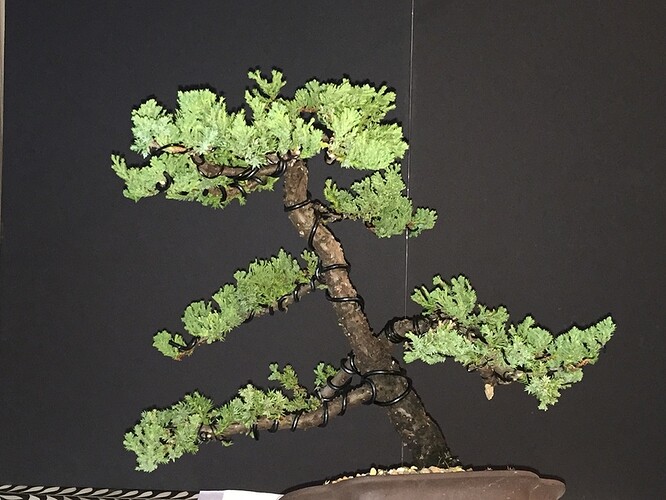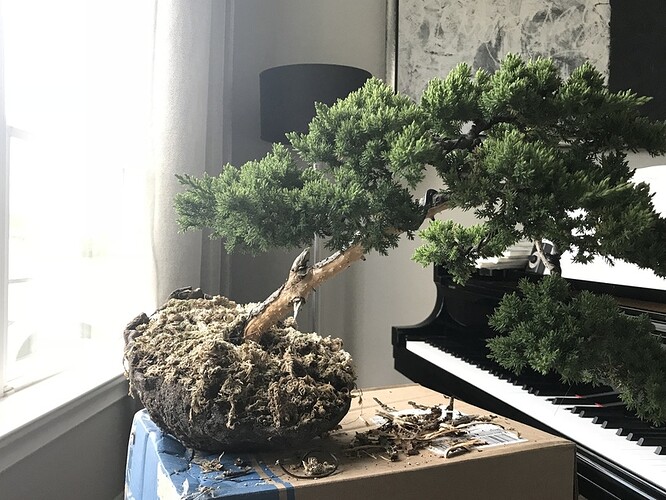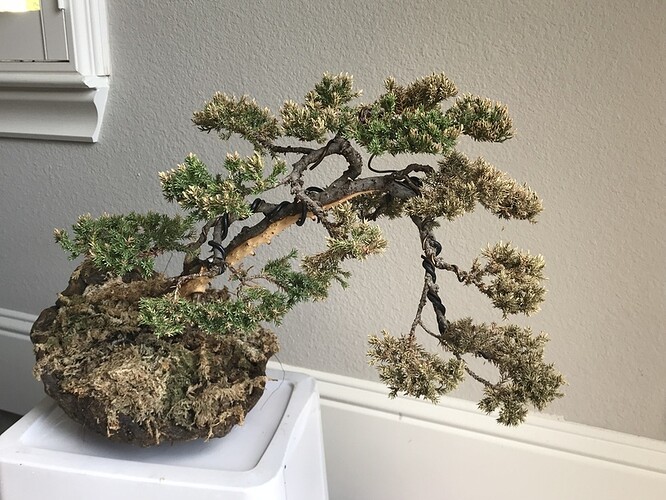I wanted to share a progression that i thought you may find interesting .. as well as it’s unfortunate death - which I believe I know why (am open to input) and therefore learned something important that I wanted to share with any other aspiring hobbyists early on the path, hopefully you enjoy!
Comments will be below each photo in the progression.
3/2016: My very first Juniper! Nursery stock Juniper Procumbens (“Green Mound Juniper” as I knew it back then). Typical nursery stock appearance and presentation.
Results after the class with my local folks - they did their best to help me don’t blame them I did my best!!
8/2016: my attempt to style and wire it on my own. I know these photos aren’t beautiful - that’s the point .. this is all ‘pre-Mirai’
I’ll fast forward to recent past .. ie ‘post-Mirai’:
3/2017: Very happy with the work at this point and feel I am learning something from Mirai and it’s hopefully starting to come through in my trees - I’ll be ready for Kokofu in the Fall!!
12/2017: “Bonus” photo - I live in HOUSTON, TEXAS; this is unheard of; needless to say I woke up at 5am and took a bunch of pictures of the garden before heading to work and it melted
5/2018: appearance prior to the working that killed it; very healthy and vigorous and only other work (not imaged) was a mild pruning in the spring prior to bud push
5/2018: Late spring = live vein reduction time! In addition to watching the stream again I also discussed this tree with Ryan via 1-on-1 to get some pointers and this is the result of that work. I did a 50% reduction; I thoroughly enjoyed this session. Stylistically I was very happy with the results and excited to be moving this tree’s design forward!!
After-care: I expected a reduction in water uptake and transpiration so I moved it from my full sun automatic watering garden location to my morning sun / afternoon shade hand-watering section.
I missed watering it one day (hence why I use an automatic system; day job, busy, etc) .. if nothing else this demonstrates how important water balance is and how delicate the post-op care needs to be for something as severe as reducing 50% of the vascular highways that move water up the trunk; at this point I moved it into my garage with partial sun and no wind and continued to hand-water it.
I missed another day watering and that was the nail in the coffin.
Post-mortem Discussion and what I learned:
-
I do believe I could have kept this tree alive if I could have watered appropriately - the photos don’t express this well, but the tree literally took a visible quantum leap toward death after each missed watering and I do believe this is the proximate cause of death.
-
I made a technical error which made the tree weaker than I thought: I did 50% live vein reduction accurately (even measured it out and was very careful), but, if you look carefully at the photo, you will see a relatively large (crappy-looking) ‘jin’ on the back (on the viewer’s left in the photo) about 1/3-1/2 way up the trunk - this effectively reduced my live vein down beyond 50% and probably left about 15-20% functioning live vein .. I feel this set me up for failure, horticulturally, given my limitations on resources and time to provide 24/7 ‘ICU’ level care to my trees.
This tree was my first Juniper and the closest I’ve gotten to a reasonably well-styled, believable ‘Bonsai,’ on its way to refinement; I was extremely disappointed with its loss and am I glad I learned something; hopefully you all do as well.
Silver-lining post-script:
Like all good cheesy movies, I leave you with a ‘cheap’ but satisfying narrative post script: my tree has been resurrected! Yes! He has a twin brother!!! see below…
My supportive wife did not catch the Bonsai bug like I did - so I have taken over her tree that was started at the same time - live on, Grasshopper!









